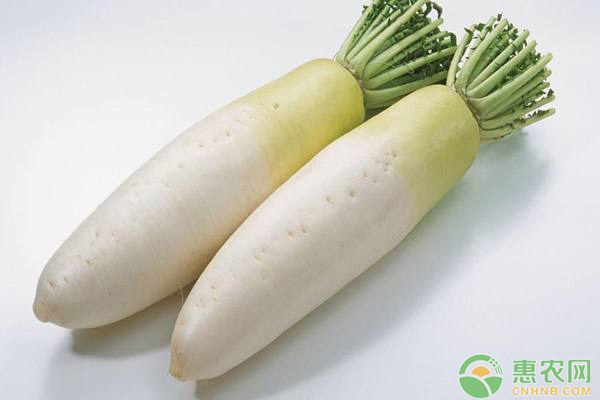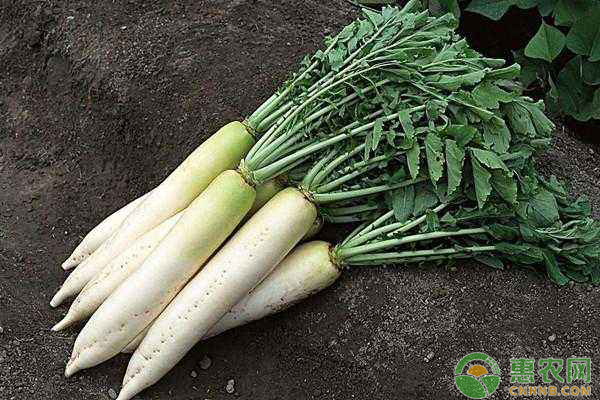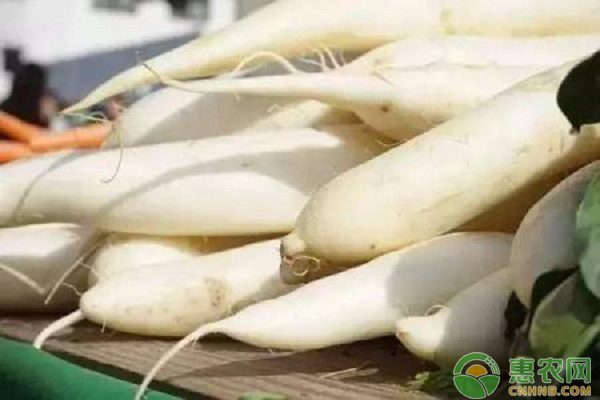The nutritional value of radish is very high, so it is a popular vegetable, and the market has broad prospects. Want to grow good radish is the pursuit of all growers, then Xiaobian will talk about how to produce high quality and high yield radish.

First, white radish cultivation technology
1.1, plot selection
Cultivated radish should choose sandy loamy land with flat terrain, good light, rich organic matter, deep soil layer, fertile soil and convenient drainage and drainage, avoiding thin soil, hard soil, soil density or gravel. Waterlogged plots are planted.
1.2. The climatic characteristics of the sowing season are high temperature and drought in summer and low temperature and cold in winter. Although the radish can be sown from mid-July to early October, from mid-February to early April, the best sowing season is September. The radish has high yield and good quality. Premature sowing is affected by high temperature and drought, and the quality of radish is poor. In spring, the yield is lower and the disease is more. If the cornice is arranged reasonably, 3 radishes can be planted in the same plot for 1 year.
1.3, soil preparation and fertilization
In the newly opened field, the roots, grass roots, gravel and other impurities in the soil should be removed. After the soil is ploughed and sun-baked, 2,000 to 3,000 kg of high-quality decomposed organic fertilizer and 40 kg of potassium sulfate compound fertilizer are applied per 667 m2. 95% borax 1.5~2 kg, after the second ploughing of the soil, the box (1.6 m) is made into a sorghum with a height of 25-30 cm and a width of 1.2 m. The soil is broken and leveled to make the middle. Slightly high, slightly lower on both sides of the turtle-shaped face. Radish sown in mid-late September and spring is generally required to cover the mulch.
1.4, white radish sowing
Seed germination rate should be determined before sowing. The cultivation of radish is carried out by means of live broadcast. The live broadcast is divided into three types: spread, strip and hole seeding. The seeding and seeding are larger, and the workload of seedlings and seedlings after emergence is also large. Therefore, professional growers basically use hole sowing and hole sowing. The method is to open a shallow hole with a depth of about 3 to 5 cm on the crotch surface by a line spacing of 30 cm × 25 cm, and seed with a higher germination rate is planted with 2 to 4 seeds per hole, and the seed should be evenly spread in the hole. After sowing, the culture soil covered with fire ash, decomposed manure and vegetable garden soil and sieved is about 0.5 cm thick, and then water is sprayed. Cultivate autumn radish, sunny day should be covered with a layer of shade net to cool and moisturize, to reduce the number of hydration during emergence.
1.5, white radish planting field management
1.5.1, seedlings and seedlings
The shading net should be uncovered in time after the land covering the shading net emerges. The radish seedling stage should be carried out once and the seedlings and seedlings should be carried out. The seedlings should be carried out after the true leaves of the radish, mainly to remove the weak seedlings and the dense seedlings. The timely removal of the shading net and the intercropping are the key measures to prevent the radish from growing. The seedlings are generally in the seedlings. It is carried out when it is 6 to 7 true leaves. When the seedlings and seedlings are planted, the seedlings should be kept according to the cultivars. For early maturing or middle fruit type varieties, such as short leaf No. 13, in general, 3 plants per hole, and 2 plants per hole after fixed seedlings; large fruit varieties such as Deri 2 , Han Yubai, Han Yuchun, 2 strains per hole at the time of seedlings, and 1 seed per hole after the seedlings were fixed.
1.5.2, water management
Radish is not drought-tolerant, and the water shortage in the seedling stage is easy to cause the plant to be infected with virus disease. When the water is lacking in the late growth stage, the radish fleshy root grows thin, the skin is thick and hard, the spicy taste is heavy, and the hollow is not enough, which leads to the plant. The leaves are long and the fleshy roots are poorly developed. Therefore, according to the amount of precipitation, the level of the groundwater level and other conditions to determine the number of watering and the amount of watering each time, but also according to the different stages of growth and development of radish.
Seedlings should be poured less frequently, so as to prevent the plants from stagnating due to lack of water and causing viral diseases. Before the "breaking belly", seedlings should be planted to promote the growth of roots deep into the soil layer. During the vigorous growth of the leaves, the water needs to be large, and water should be watered to prevent the leaves from growing. The fleshy roots should be fully and uniformly filled with water to prevent cracking; in the later stage of growth, water should be properly watered to prevent hollowness. Watering should be stopped 5 to 7 days before harvest to improve the quality and storage capacity of the fleshy roots.
For flat plots, furrow irrigation can be used in the rapid growth period of the leaves and in the early stage of fleshy root enlargement, but the depth of irrigation should not exceed half of the ridge. The radish should be kept as loose and breathable as possible in the whole growth period. The soil can be easily knotted. After the radish is planted, a small hole is opened at about 10 cm from the seeding hole to replenish water. This method is to prevent soil caused by watering. The knot has a good effect.
1.5.3, top dressing
The growth period of white radish is not long. In the land with high soil fertility level and sufficient base fertilizer, it is only necessary to carry out two top dressings during the whole growth period. The first time is carried out after the end of the seedling stage, and the watering is applied every 667 m2. Urea or ammonium sulfate 10 ~ 20 kg; the second time in the growth of fleshy roots, 15-20 kg of compound fertilizer to promote the expansion of fleshy roots. In plots with insufficient base fertilizer and poor fertility, appropriate topdressing should be applied 1 or 2 times. During the rapid expansion of the fleshy roots, it is also possible to apply 1 to 2 kg of boron fertilizer per 667 m2 in combination with pest control.

2. White radish pest control
2.1, disease prevention
The main diseases of radish are soft rot, black rot and mosaic virus. Black rot is the most common disease of radish. It is more common in late autumn. The symptoms are not obvious at the beginning of the disease. After infection, the plant turns yellow from the leaf edge. After the disease develops gradually, the root of the diseased plant is slightly beige compared with healthy plants. Color, the inside of the root becomes empty black. Both soft rot and black rot are bacterial diseases, which can be used with 72% agricultural streptomycin WP 500 times, or 30% DT WP 600 times, or 47% rigine WP 600 times. Take control. Mosaic virus disease occurs in the early stage of cultivation of radish plots. It should try to avoid excessive drought in the field during seedling period and prevent and control aphids in time. The early stage of the disease is 50% virus A 500 times liquid or 1.5% plant disease. 1 000 times of liquid for prevention and control, once every 7 to 10 days, for 2 to 3 times.
2.2, pest control
The main pests are aphids, rapeseed meal, cabbage caterpillar, diamondback moth and yellow bell. Aphids are the most common pests of radish. They can be controlled by 10% imidacloprid WP 2,000 times or 50% piran WP 2,000 times. Rapeseed is the most harmful pest to radish. The pest starts from the newly hatched larvae and leaves the leaf surface to feed on the heart. At the age of 4 to 5, the heart or the petiole breaks into the stem and root. For the disease, rapeseed meal, cabbage caterpillar and diamondback moth can be used 3.2% Avi·Cyanide (Zhongxun Zhanguan) emulsifiable concentrate 2000 times liquid, or 5% Taibao emulsifiable concentrate 2000 times liquid, or 5% card dead emulsifiable concentrate 2 000 The liquid is alternately controlled. The yellow curved beetle can be controlled by 40% lesbian emulsifiable concentrate 1 000 to 1500 times solution or 2.5% kung fu emulsifiable concentrate 2 000 to 3,000 times.

3. Common problems and solutions in radish planting
Although the radish cultivation method is simple, it often causes devastating blows to the growers due to the phenomenon of splitting, cracking, uncooked convulsions, jealousy, black heart, and black skin.
3.1, radish split, cracked root
Poor soil physical and chemical properties, shallow soil layer, gravel or application of insufficiently decomposed organic fertilizer will cause radish splitting. Therefore, it should be planted and prohibited by selecting plots with deep soil layers, high organic matter content and few stones. Decomposed organic fertilizer to prevent radish splits.
The reason for causing radish roots is that the soil moisture supply is uneven during plant growth. For example, in the early stage of autumn and winter radish, the radish root cortex is gradually hardened. When the temperature is suitable and the water is sufficient, the fleshy root hardened cortex Cracking occurs because it cannot grow accordingly. The solution is to timely watering and irrigating in the early stage of radish growth in case of high temperature and drought, and evenly supply water when the fleshy roots are rapidly expanding in the middle and late stages.
3.2, uncooked convulsions
The radish root of radish begins to twitch and bloom when it has not reached the maturity of the commodity. It is called immature convulsion, and the cause of immature convulsion is vernalization. The low temperature value and time required for vernalization of radish have a great relationship with the variety, so it is suitable. Variety and reasonable arrangement of sowing date are of great significance in preventing immature convulsions, and varieties that are resistant to vernalization should be selected for late autumn or spring cultivation. The Hengyang area is not suitable for radish sowing from late October to late January, and radishes sowed in mid-late September to late October and spring should be covered with plastic film as much as possible.
3.3, radish heart, black heart, black skin
The radish heart seems to be an over-mature phenomenon, but in fact, during the radish growth process, the high soil temperature in the early stage, the late drought or the uncooked convulsions will cause the heart, and the meat should be dense, the dry matter content is high, and the resistance should be high. At the same time, the soil moisture content of the fleshy roots is scientifically managed and harvested in time to prevent its heart. The reason for radish black heart and black skin may be black rot caused by pathogen infection or boron deficiency in soil. Therefore, the prevention and control of black rot should be done and boron fertilizer should be added.
4, harvesting white radish
When purchasing radish seeds, the number of mature days indicated on the package is determined according to the seeding cultivation of the variety at the optimum sowing date, so the number of days indicated on the package cannot be used as the harvesting standard. Early planting in the fall, the time required for harvesting will be slightly shorter, and in the late autumn, the time required for harvesting will be extended accordingly. Therefore, the harvesting time of radish should be determined according to the actual situation in the field. Generally, after the harvesting standard is reached, the leaves of the plant will begin to yellow, and the extracted radish will be large, round and shiny. Many varieties can maintain good commerciality for a long period of time after reaching the harvesting standard, which will prolong the harvest period. At the time of harvesting, the radishes that have reached the harvesting standard are pulled out, arranged in order on the clam surface, and the radish leaves are removed from the root and neck for 3.5 to 5 cm, and then the radish baskets are transported to the cleaning workshop by a transfer vehicle. In the process of harvesting, transportation, cleaning and handling, it should be avoided to scratch the fleshy roots.
Butterfly bean flower is also known as butterfly bean flower, blue butterfly flower, blue butterfly, butterfly blue flower, and other aliases such as butterfly sheep bean and bean bee. Its petals can be used for dyeing and eating, and are rich in vitamins A, C and E. It is rich in anthocyanins, which can improve immunity, help and promote skin elasticity and collagen production, and has antioxidant effects.
Butterfly Pudding Powder,Blue Pigment,Butterfly Pea Flower Powder,Butterfly Pea Pollen
Shaanxi Zhongyi Kangjian Biotechnology Co.,Ltd , https://www.zhongyibiotech.com